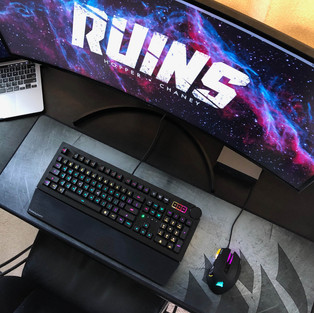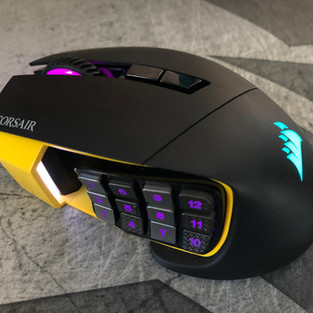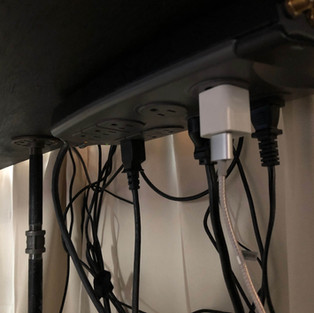Healing Through Mechanical Keyboards and My 2020 Workstation Overhaul
- Christopher Hopper

- Sep 12, 2020
- 7 min read
I traded in my last iMac for a MacBook Pro (MBP) in mid-2006 and haven’t looked back.
I’ve owned several of the Apple’s flagship laptops, taking them on multiple trips to Europe, Asia, and Latin America, and flipping the 13” screen open in hundreds of hotel rooms and cramped coach airline seats. But traveling aside, it’s served as my office computer as a matter of convenience.
For more than fifteen years, the MBP has been my workhorse, helping me cut dozens of albums on Logic and Pro Tools, write more than eighteen novels in Scrivener, run a production and marketing company on the Adobe suite of products, and manage a church and several restaurants with Evernote and Microsoft Office.
The one thing the MBP didn’t do for me, however, was help my physical body. Specifically, my fingers, hands, wrists, shoulders, neck, and upper back. You might say that my older body is taking the proverbial beating dished out by my younger self. And boy, does it suck.
Bring On The Pain
I decided to make a career shift to write full-time two years ago. Within just two months of writing 5,000 words per day, I experienced acute aching in my index and middle fingers joints, and my thumbs. And on days where I’d hit 10,000 to 12,000 words, the pain was almost unbearable, extending into my knuckles and hands, with muscle cramping and vertebrae pain in my neck. It wasn’t the first time that I’d experienced these problems, but it was the most significant.
As a trained musician, I already stretched my hands and fingers daily to stave off the dreaded carpal tunnel syndrome. But no matter how much I stretched, iced, or massaged these problematic areas, the only relief I got was if I stopped typing for days at a time.
This went on for over eighteen months. I shared my pain with no one, as typing was my livelihood. I couldn’t bear the thought of telling my wife that the decision I’d made to become a professional writer was in jeopardy because I was developing what I was sure was chronic arthritis.
A Glimmer of Hope
It wasn’t until June of 2020, while having late-night drinks on our neighbor’s front porch, that I opened up.
Robin, a retired nurse turned tech firm researcher, was instantly concerned when I described my symptoms. And her husband Josh, a software engineer and brand designer who spends more time typing than even I do, said, “Bro. You’re doing something wrong.”
We went into his office, and he let me examine his setup. When I sat in his armless office chair, laid my hands on his mechanical keyboard and standalone wired mouse, and looked up at his curved monitors, I instantly felt the difference. My body relaxed, my hands fell in place, and I felt ready to go. It was a far cry from my hunched over and cramped Gremlin-esque pose on my MBP at various tables or couches around the house.
Josh explained the importance of hand position and how things like an old school mouse—as archaic as they seem—conform to the hand’s natural position rather than fight it. This info was stuff I’d heard before but ignored. Yet, between my pain and Josh’s fancy glowing hardware, I was listening.
While I was still pretty convinced that I had arthritis and doubtful that bulky hardware could make a difference, I was growing more desperate for relief by the day.
The Checklist
Compelled by Josh’s setup, I decided to build a workstation. If it didn’t work, I could return everything and find different ways to manage my pain.
My experiment checklist included:
• An armless, comfortable office chair. The “armless” aspect might sound counterintuitive, but it’s not. It allows for a wider range of motion and causes the arms to use the keyboard’s wrist rest more naturally.
• A desk height of 27”. This is my elbow’s natural height off the floor with the chair I use, such that my forearms can stay level. A higher desk can be used, but the chair height must rise proportionally. I wanted a small step under my desk to bring my feet up, recreating the semi-reclining position I saw Josh use.
• A curved ultra-wide monitor. Ensuring that this monitor was at eye level to help keep my neck, shoulders, and upper back from aching was imperative. The “curved” aspect also reduces eye strain as the monitor’s outer edges extend away from the center.
• A USB-C docking station. I wanted to turn my MBP into a peripheral screen but still be the all-powerful brain. The hub needed to have lots of connectivity options for USB, HDMI, USB-C, MicroSD cards, and 1/8” audio.
• A mechanical keyboard and mouse. While all the components are essential, this oddly “old school” pair turned out to be the most critical part of the entire setup. Mechanical keyboards have long been the hero of coders everywhere, and not just for their lovely sound. More on that in a moment.
The Chair and Desk
I already owned an old office chair that I liked, and I found a way to remount the arms upside down so that they still acted as the main supports for the chair’s upright back.
The next thing was getting a suitable desk.
Since I tend to like building my own furniture, and I was discouraged with the lack of affordable adjustable desks on the market, I decided to make my own. It consisted of a sanded and stained plywood top and black iron pipe for legs that I could easily adjust. I also attached a multi-port surge-protected power strip to the underside.
In the end, it took me about six hours to create something that would serve me well.
Keyboard, Mouse, and Docking Station
As for the electronic hardware, I started at Best Buy, where I was able to try my fingers on seven or eight different brands of mechanical keyboards and mice right in the store. (Yes, lots of hand sanitizer was employed). This experimentation turned out to be far more important than I realized, as not all keyboards are equal, and personal preference is everything.
From key size and push-down pressure to weight and sound (yes, the sound), going from one keyboard to the next gave me a real sense of the many differences. These units aren’t cheap either. I liked all of the ones over $100 (“naturally,” as my budget-conscious wife would say). I soon realized that the keyboards weren’t the gimmicky tools reminiscent of a bygone era. Instead, these were finely tuned weapons of word war. (Plus, they have programmable LED lights).
Done and done.
As for mice, I ended up going with the Corsair Scimitar Pro RGB. Aside from looking like the cross between a stealth fighter and a yellow alien spaceship, it’s overall feel, track wheel, smooth finger clicking, and programmable side number panel sold me.
My top three favorite keyboards included:
But the keyboard I ended up going with was gifted to me, along with a new monitor and USB-C docking station. When my longtime friend and Ruins of the Galaxy alpha reader David heard of my pain, he surprised me with three shipped boxes of hardware, all of which would finish my checklist.
The gift boxes included:
Das Keyboard 5Q (Mine, no longer sold: DKPK5Q0)
The Results
After bringing my desk into my bedroom office and setting up all my new toys, it was time to work.
I will be the first to admit that going back to a “clunky” mechanical keyboard and “old school” wired mouse after nearly fifteen years of my fingers dancing over a sweet Apple aluminum chassis took some getting used to. At first, everything felt slower. The mouse was in a weird place, I didn’t have the same touchpad gestures, and the keys had actual travel to them.
But within two days, the miraculous happened. My pain started to abate.
At first, I thought it was a fluke. Maybe something I ate, or a change in the barometric pressure.
But as two days turned into two weeks, and none of the muscle or joint pain returned, my skepticism turned into wonder and delight.
That was June of 2020. It is now September of the same year, and aside from minor cramping I can attribute to overly long workdays, none of my former pain has returned.
It’s gone.
The Attribution
Of all the components in my new setup that I can attribute my pain relief to, the keyboard and mouse are the two most important. I say this because, while I love my extra-wide curved monitor and my comfy armless chair, the absence of either of these doesn’t cause me nearly as much pain as does just one hour spent returning to my MBP’s proprietary hardware interface.
In fact, within twenty minutes of tapping on the touchpad, my right-hand index finger starts to pulse in pain. Yes, it’s probably nerve damage at this point. Likewise, my fingers begin to swell, and my wrists ache.
Where before, I held my wrists over the MBP to avoid the touchpad and the laptop’s angular edges, now the heels of my palms relax along the keyboard’s built-in wrist rest. Similarly, my hands extend over the mouse’s ergonomic form rather than stay locked up like a bird claw.
I also notice that I type much harder on my MBP than my mechanical keyboard—not because one caused the other, but because I find myself typing less hard on the mechanical keyboard as a matter of enjoyment. Is it the sound? The motion? Key-actuation satisfaction? I’ll leave that to the scientists. But I do believe there’s something to “letting the tools do the work,” an expression that takes me back to when my dad taught me how to use a drill and hand saw.
My assumptions that a mechanical keyboard and mouse were nothing more 1980s nostalgia holdovers were dispelled once I realized that they taught me to type better. They were taking my pain away. They helped heal me.
Conclusions
If you’re struggling with some of the symptoms I described above, I recommend taking my experience to heart and trying something new. Even if your pain doesn’t match mine, all the more reason to get a jump on things before they become real problems. And, as previously mentioned, while all the components working together were necessary for my healing, the mechanical keyboard and mouse would be my first investment were funding limited.
Here’s to writing many more pain-free words.
OTF,
Christopher





















It’s fascinating how something as tactile as a mechanical keyboard can spark healing and creative flow. I’ve had a similar experience—small changes in my workspace can completely reset my mindset. What stood out most is how intentional design fuels productivity and personal growth. That’s also how I approach brand visibility: the environment matters. A smart setup combined with strategic communication creates real impact. That’s where https://thundermarketingsolutions.com/why-is-outreach-marketing-important-for-brand-awareness/ comes in. The way they break down connection-driven strategy shows how thoughtful execution—just like workstation tweaks—can lead to lasting results in outreach and awareness.
Chris - This really resonated with me. It's great to hear you're doing better. Maybe over time some of the nerve damage will lessen, or maybe go away entirely! I've worked in IT for close to 30 years now. For us computer desk jockeys, desk equipment and layout can make the world of differnce. Did you by chance also experience numbness in fingers? Maybe six months ago I started have problems where my middle fingers on both hands start to go numb. Literally can't feel the keys on the keyboard! I just ordered a new chair that is adjustable and the arms can rotate down and out of the way. I'll check out the keyboards you mention. I used to…